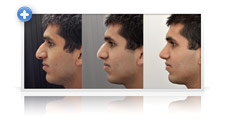
Most commonly requested by both men and women.
A significant proportion of patients seeking rhinoplasty surgery are concerned that the sheer size of their nose is disproportionate with their facial features.
Areas of particular concern are the presence of a bump on the bridge of the nose, excessive width of the bridge tip of the nose, and possibly excessive width of the nostrils.
Part of the consultation process is to help determine which features contribute more significantly to this impression, and therefore which should be addressed as a priority.

Using computer simulation in the process of assessment, makes it easier to appreciate the degree of change required in order to achieve balance, but also the characteristics of the nose shape that fits nicer with the rest of the features.
The bump on the bridge of the nose is primarily made of cartilage (lower two thirds) and only the top third is due to the nasal bones. Reducing the bump can target either a straight profile, a slightly concave one or in some instances a slightly convex one, but not as prominent.
Reduction in the tip of the nose requires a more complex combination of lowering the cartilages (that decrease projection) and reshaping that allows for a narrower, more and delegate or more defined to contour.
In order to achieve more significant correction and control for the shape of the tip of the nose, it is often necessary to use an open tip approach during the rhinoplasty, and combine it with some thinning of the skin of the tip and supra-tip (area just above the tip).
When the nostrils are relatively wide, an alar base reduction is the procedure capable to achieve and narrowing effect, and involves removing a wedge of tissue in the area where the nostrils meets the cheek. Inevitably this leads to a fine scar to the area.
One of the main conflicts in achieving satisfactory results with reduction rhinoplasty is related to the combination of reduction in the tip projection and narrowing of the tip the context of relatively thick nasal tip skin.
This doesn't mean that patients with thicker skin of the tip of the nose cannot have a more defined appearance, but the degree of correction will be more limited, and achieving change will take more effort.
Like in all situations with rhinoplasty, it is important to understand that the results of surgery will always be different from the computer simulations used during planning.

In particular, in the case of reduction rhinoplasty, this is also related to the fact that the skin needs to shrink in and adapt to the new cartilage framework shape. The thicker the skin, the more difficult this becomes and the longer the process.
![]() Questions? Just ask.
Talk to our helpful team or book a consultation
with Mr Lucian Ion. Call 0207 486 7757
Questions? Just ask.
Talk to our helpful team or book a consultation
with Mr Lucian Ion. Call 0207 486 7757
Areas of particular concern are the presence of a bump on the bridge of the nose, excessive width of the bridge tip of the nose, and possibly excessive width of the nostrils.
Augmentation rhinoplasty refers to the type of surgery where the dimensions of the nose are increased.
The term has been associated with rhinoplasty for population groups with softer nasal contours, like the Afro-Caribbean, the Far Eastern or Pacific Rim populations.
Deviations of the bones and cartilages of the nose, can be reset with relatively good success rate within the first week to 10 days after the injury.
About our practice
Facial rejuvenation
Breast surgery
Body contouring
More information